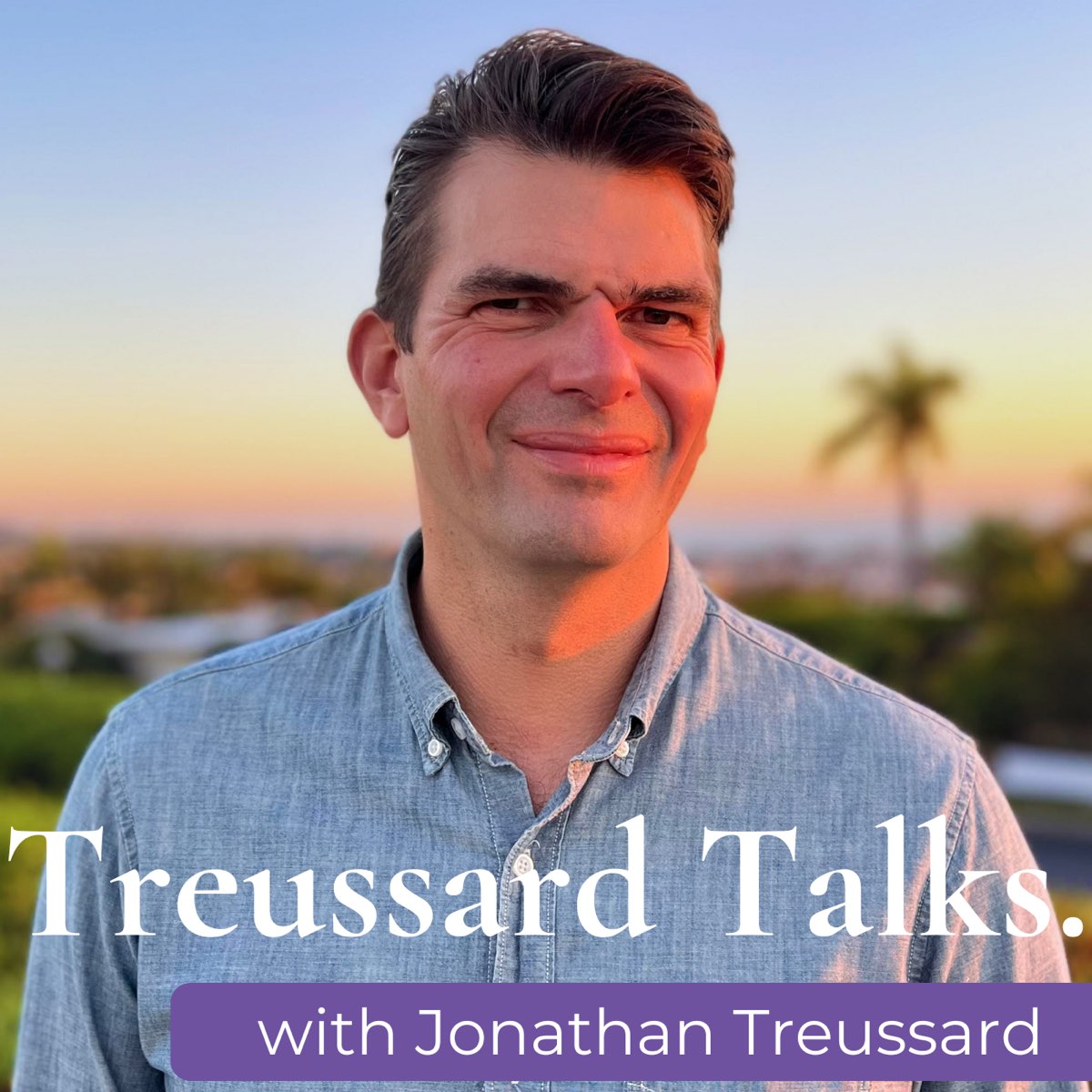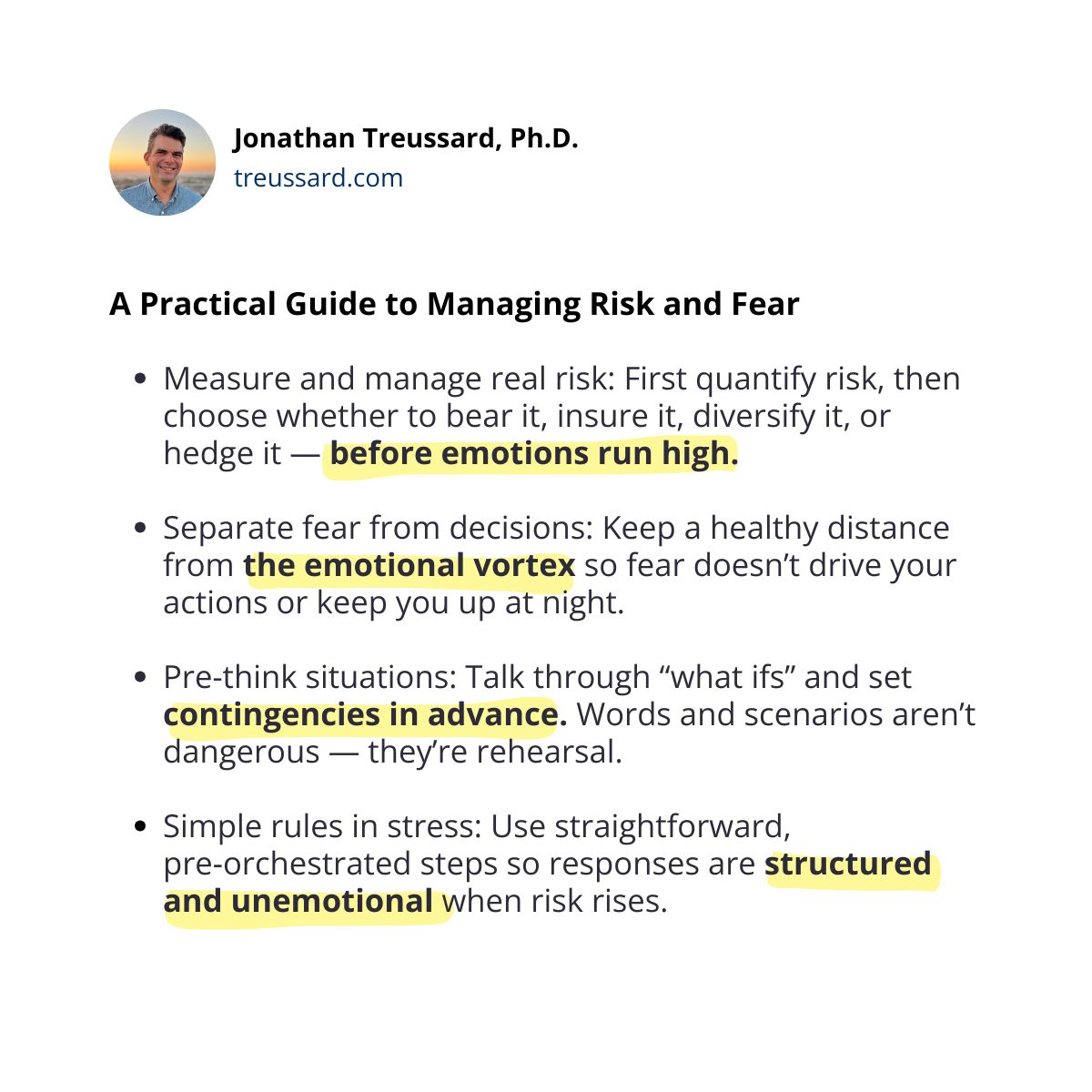- WEALTH, EMPOWERED by Jonathan Treussard
- Posts
- Fear Moves Markets. Keep It From Moving You.
Fear Moves Markets. Keep It From Moving You.
TL;DR: Risk is measurable. Fear is contagious. Your wealth needs a plan for both. Especially now. “A Practical Guide to Managing Risk and Fear” is at the end of this piece.
I'm pretty sure it's the time of year, but I've had Leonard Cohen on the brain lately.
There is no Leonard Cohen song that I don't love.
But here are some verses that are hanging in the air at the moment.
"I have changed my name so often / I've lost my wife and children / But I have many friends / And some of them are with me.
An old woman gave us shelter / Kept us hidden in the garret / Then the soldiers came / She died without a whisper."
That's from "The Partisan."
And then there is the late-80s AIDS-crisis-era masterpiece "Everybody Knows."
"Everybody knows that the boat is leaking / Everybody knows that the captain lied.
Everybody got this broken feeling / Like their father or their dog just died."
What I love about Cohen's lyrics is how often they speak to facing darkness with determination, to facing danger without fear.
I wonder what he'd say about where we're finding ourselves now.
From Uncertainty to Risk to Fear
Let's make a few things plain.
As they say, there isn't much that's for certain in life, outside of death and taxes.
Now, in a world filled with uncertainty, not all of it qualifies as risk.
For something uncertain to deserve the label of "risk," it has to have a potential impact on what economists would call your welfare. What we'll call your ability to enjoy life.
A coin flip creates uncertainty.
But unless you decided to bet next month's rent on it, who cares if it turns up heads or tails.
But once something is a risk, a proper risk of the financial kind — one that could make you poorer or richer — we have a reasonably full toolbox to deal with it.
→ We can measure it.
→ We can decide to bear it.
→ Or we can insure it, diversify it, and hedge it.
I'm speaking from experience, as someone who joined the Ziff family office in New York City to serve as risk manager in June of 2008, weeks before the Great Financial Crisis cracked wide open.
Risk is nobody’s definition of a good time.
But it’s structured and straightforward, in a lot of ways.
Then there is fear.
Fear is a mess.
It’s not neat and mathematical.
It’s raw and psychological.
Risk doesn’t keep you up at night. Fear keeps you up at night.
And as my recent guests on TREUSSARD TALKS Rob Arnott and Ed McQuarrie put it, fear is omnidirectional, social, and ‘arational.’
(For what it’s worth, Rob founded and leads Research Affiliates, a $150B global asset manager. And Ed is a highly respected economist, whose work has received serious research awards.)
Fear is Omnidirectional.
Stay with me for a second here. Say the magic word "money" three times in a row. And notice that the moment you think about money, you're worried. You're worried about losing it. You're worried about it not growing enough. Not keeping up with whatever concept you have of what intelligence colliding with money "should" produce. Fear allows you to be worried about everything and its opposite all at once.
You can literally feel fear in the air around you. When something scary is happening, something that threatens our sense of safety and human hierarchy, fear becomes contagious. I learned that from taking the subway at Grand Central in the dark days of 2008. When everyone left their desk at whatever hedge fund and whatever bank in Midtown Manhattan after sundown in the Fall of 2008, we all looked like we'd seen our own shadow. Tapping into the feedback loop of fear from those around you… it might have been human, but it wasn’t necessarily helpful. Maybe that's why Warren Buffett happily stayed in his hometown of Omaha, Nebraska. Maybe that's why I enjoy living in Newport Beach today. To keep a healthy distance from the emotional vortex.
Fear is ‘Arational.’
A close friend of mine who's a serious institutional investor listened to my conversation with Rob and Ed and reached out: "What's this ‘arational’ thing?" I said, neither rational nor irrational. It just is. Fear just is. Sometimes it serves us and sometimes it’s just noise, a trip-up of an old evolutionary wire.
Anyway, that’s why Rob and Ed claim — with some serious research to back it up — that Fear, Not Risk, Explains Asset Pricing.
And I hope you’ll tune in.
I think it might help you as you process risk and uncertainty, and put fear where it belongs.
But it might also help you understand how I process information, as someone who’s been doing this for nearly two decades.
I deal with risk all the time. That’s kind of “the job.”
I track down “what ifs” daily, some very well traveled and some much more exotic.
But I have internalized the simple fact that words are not dangerous.
Thoughts are not dangerous.
We can talk about all kinds of risks and think through all sorts of scenarios.
We may even choose to put contingencies in place, just in case.
But as long as you’re not approaching it from a place of fear, you’re not joining the circus.
So yes, I contemplate weird scenarios all the time.
And it doesn’t register an emotional reaction in me.
At least, not often.
In this regard, I hope you’ll join me.
Listen to $150B quant manager Rob Arnott on TREUSSARD TALKS (feat. Ed McQuarrie) — start here on Apple Podcasts. Prefer another platform? Find it on Spotify or YouTube.
Next Steps
→ Share: Forward this newsletter to a friend or colleague who would values clarity about markets and wealth
→ Listen: Catch my conversations on TREUSSARD TALKS on Apple Podcasts, Spotify, or YouTube
→ Connect: Email me with your portfolio questions and we can navigate them together
And now, our handy cheat sheet: “A Practical Guide to Managing Risk and Fear.”
Disclaimer: All content here, including but not limited to charts and other media, is for educational purposes only and does not constitute financial advice. Treussard Capital Management LLC is a registered investment adviser. All investments involve risk and loss of principal is possible.
Full disclaimers: https://www.treussard.com/disclosures-and-disclaimers.

